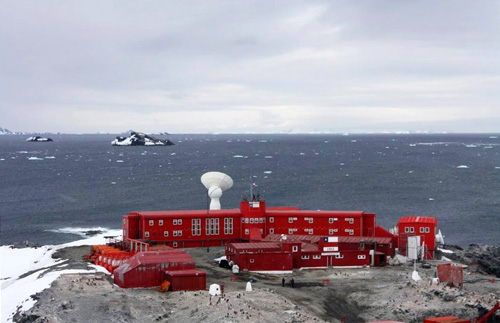This recent cut-paper composition takes Chile's General Bernardo O’Higgins Antarctic Base for its theme. The artwork is part of my series on Antarctic research stations operating on the continent and its nearby islands. With these posts I'll be examining the bases' fields of study, their differing implementations of the Protocol on Environmental Protection to the Antarctic Treaty, and their associative architecture, infrastructure, and role in the context of a changing planet.  Bernardo O'Higgins base is a year-round research facility near the tip of the Antarctic Peninsula. Named for the leader of the Chilean military forces that won independence from Spain, O'Higgins is administered by the Chilean Army which provides logistical support, maintains the infrastructure, and assists in scientific work at the station. The base conducts research into ultraviolet measurements, hydrology, oceanography, and human physiology as affected by periods of darkness and light. It also supports studies of the magnetosphere which envelops and shields the planet from the solar wind. Prominent on the site (and in the center of my artwork) is the German Antarctic Receiving Station (GARS), a satellite ground station enabling reception of high-resolution remote sensing data on the south polar region. The nine-meter parabolic antenna is a joint venture between the German Aerospace Center (DLR) and the Instituto Antarctico Chileno (INACH), Chile’s Antarctic research institute. O'Higgins was established in 1948, making it one of the longest-running Antarctic bases of continuous operation. Interestingly it was built in the midst of a Gentoo penguin rookery which still exists. This perch, separated from the Antarctic continent by 50 meters of water at high tide, offers a unique opportunity to study the wildlife and ecology of the region. According to the most recently issued U.S. Antarctic Treaty Inspection Report: "The base keeps a log book documenting environmental impacts on a weekly basis. Penguin nests, eggs and chicks are monitored, as well as other birds in the vicinity of the base. All monitoring is visual; there is no tagging or touching of the birds." The report however adds: "While base personnel said they attempt to maintain a distance from the nesting penguins to prevent any disturbance, many of the nests are on or near base facilities where people must pass during daily activities, and thus close human contact with these animals is unavoidable."
Bernardo O'Higgins base is a year-round research facility near the tip of the Antarctic Peninsula. Named for the leader of the Chilean military forces that won independence from Spain, O'Higgins is administered by the Chilean Army which provides logistical support, maintains the infrastructure, and assists in scientific work at the station. The base conducts research into ultraviolet measurements, hydrology, oceanography, and human physiology as affected by periods of darkness and light. It also supports studies of the magnetosphere which envelops and shields the planet from the solar wind. Prominent on the site (and in the center of my artwork) is the German Antarctic Receiving Station (GARS), a satellite ground station enabling reception of high-resolution remote sensing data on the south polar region. The nine-meter parabolic antenna is a joint venture between the German Aerospace Center (DLR) and the Instituto Antarctico Chileno (INACH), Chile’s Antarctic research institute. O'Higgins was established in 1948, making it one of the longest-running Antarctic bases of continuous operation. Interestingly it was built in the midst of a Gentoo penguin rookery which still exists. This perch, separated from the Antarctic continent by 50 meters of water at high tide, offers a unique opportunity to study the wildlife and ecology of the region. According to the most recently issued U.S. Antarctic Treaty Inspection Report: "The base keeps a log book documenting environmental impacts on a weekly basis. Penguin nests, eggs and chicks are monitored, as well as other birds in the vicinity of the base. All monitoring is visual; there is no tagging or touching of the birds." The report however adds: "While base personnel said they attempt to maintain a distance from the nesting penguins to prevent any disturbance, many of the nests are on or near base facilities where people must pass during daily activities, and thus close human contact with these animals is unavoidable."
O'Higgins Base made news this year when its seawaters were found to contain bacteria that are resistant to nearly all kinds of antibiotics. The research was led by Uppsala University's Björn Olsen and Jorge Hernández who detected higher concentrations of the superbugs nearer to the sewage outfalls of O'Higgins and two other Chilean bases. Linking the phenomenon to the quality of sewage treatment remains tenuous though, as Hernández noted that "Chile has provided its permanent bases with modern equipment for waste water treatment that is constantly improving." Scientists are now investigating wildlife for clues since the culprit bacteria were also found in gulls in France. Observations suggest that the bacteria may maintain their super-resilience long beyond their exposure to antibiotics, and that they may survive in the wild using animals as hosts. That possibility is of concern at O'Higgins, situated as it is in a rookery. Penguins nearby have been checked and are deemed free of that bacteria which carry genes that make the ESBL enzyme capable of destroying penicillin, cephalosporins and related antibiotics. Other types of sea birds in proximity to the station are next to undergo testing. Whatever the outcome, the existence of these microorganisms in Antarctica indicates the troubling extent to which drug-resistant bacteria are proliferating on Earth.
